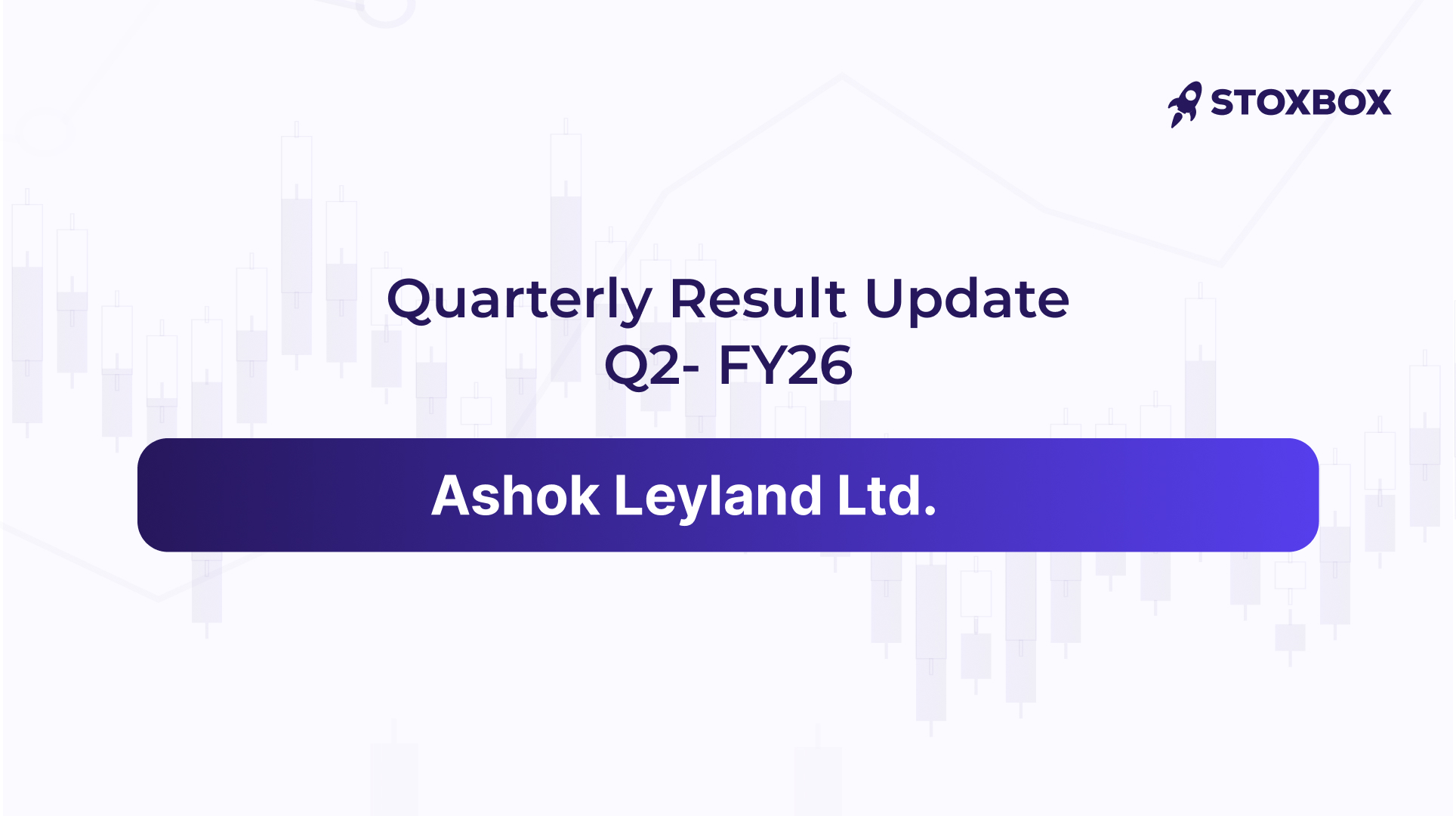Home » Core Investor Group » Ashok Leyland Ltd – Q2FY26 Result Update
Sector Outlook: Neutal
Broad-based growth across parameters; H2FY26 outlook remains upbeat
Ashok Leyland Limited reported a healthy performance for the quarter, with key metrics comfortably exceeding street expectations. The company posted a topline growth of 9.3% YoY / 9.9% QoQ to Rs. 9,538 crores, supported by a steady improvement in both domestic and export volumes. This was further aided by higher spares revenue during the period. Gross margin held broadly stable at 29.0% YoY, though it saw a sequential contraction of 52 bps, primarily due to inventory destocking. A noteworthy development was the softening of material costs despite the introduction of ACs across the MHCV portfolio, reflecting the company’s ongoing cost-optimisation initiatives. EBITDA stood at Rs. 1,162 crores (up 14.2% YoY / up 19.9% QoQ), translating to a margin of 12.2% (up 53 bps YoY / up 102 bps QoQ). Margin expansion was driven by improved realizations and stronger operational discipline. Reported profit came in at Rs. 771 crores (flat YoY / up 29.9% QoQ). The comparison was influenced by an exceptional loss of Rs. 40 crores in Q2FY26 versus an exceptional gain of Rs. 117 crores in Q2FY25. Total volumes for the quarter were 49.1k units (up 7.7% YoY / up 11.0% QoQ). The company recorded a 3% YoY increase in MHCV volumes and a 6% YoY rise in LCV volumes. Ashok Leyland also highlighted marginal improvements in market share across both segments while maintaining its strong leadership position in the Bus category. The company has also recommended an interim dividend of Rs. 1 per share, with November 18, 2025, being the record date.
Valuation and Outlook
Ashok Leyland delivered a solid Q2 performance marked by resilient margin execution, strengthening demand tailwinds and continued progress on its strategic priorities. The quarter was supported by steady domestic volumes, a strong revival in exports (up 45% YoY in Q2), and sustained growth across non-truck businesses, including buses, LCVs, spares, and power solutions, which now account for nearly 50% of revenue and remain structurally margin-accretive. Operational efficiency remains the key highlight for the company, with a softening commodity trend in Q3FY26 further reinforcing near-term margin tailwinds. The demand environment has turned incrementally positive post GST 2.0, aided by a 10% reduction in vehicle prices and improving freight demand. Management expects H2 to be meaningfully better than H1 across volumes and growth rates for the MHCV and LCV segments, with October trends indicating 7% MHCV and 15% LCV industry growth. LCVs, in particular, are seeing strong traction driven by retail demand and the success of new launches like SAATHI, which now forms over 20% of LCV volumes. The medium-term outlook is reinforced by a strong product pipeline. The company is set to launch premium heavy-duty trucks (320hp and 360hp) and new high-capacity buses in Q3–Q4, which are expected to aid both mix and pricing power. Management remains confident of a margin upcycle supported by premiumisation, favourable commodity prices and a richer revenue mix, reiterating its strategic aspiration to achieve mid-teen EBITDA margins over the medium term. Overall, the company remains well positioned to benefit from the ongoing industry recovery, rising exports, margin-accretive non-truck business and a refreshed product pipeline.
Key concall Highlights
The MHCV industry grew 4% in Q2FY26 while the LCV segment expanded 13%, with October 2025 demand remaining strong as MHCV and LCV volumes increased 7% and 15% YoY, respectively. Management expects H2FY26 to outperform H1FY26, supported by GST 2.0-led truck price reductions of about 10% and an uplift in freight demand, which should structurally boost replacement demand. In Q2FY26, Ashok Leyland reported MHCV truck volumes of 21,647 units and bus volumes of 4,660 units, with its domestic MHCV market share rising to 31% in H1FY26. LCV domestic volumes grew 6.4% YoY to 17,697 units, and Vahan market share improved to 13.2%. Exports rose sharply, up 45% YoY in Q2 and 38% in H1, supported by strong traction across GCC, Africa, and SAARC markets. Non-CV businesses performed in line with expectations, with aftermarket revenue up 11%, Power Solutions up 14%, and Defence up 25%. Capex stood at ₹417 crore for Q2 and ₹658 crore for H1, with no investments in subsidiaries. Management highlighted continued margin support from cost-saving initiatives, price recovery, and commodity tailwinds, while breakeven volumes have structurally reduced to 1,000–1,200 units per month. A ₹420 crore rough-terrain forklift order is delayed pending an emission NOC and may start in Q4FY26 or spill into FY27. Strategically, the company plans to launch new 320–360 hp heavy-duty trucks with higher torque in Q3/Q4FY26, commission its modern Lucknow bus plant to raise capacity to 20,000 units annually, and invest in next-generation battery development. Subsidiaries continued to scale well: Switch India sold around 600 buses and 600 eLCVs in H1FY26 and turned EBITDA- and PAT-positive with a 1,650-unit bus order book, while OHM now operates over 1,100 electric buses at 98% fleet availability and is progressing toward a 2,500+ bus fleet within 12 months.
Your Wealth-Building Journey Starts Here

You might also Like.
Union Budget 2025-26 Impact on Sectors
Edit Announcement Impact Companies Enhancing the credit guarantee cover for...


